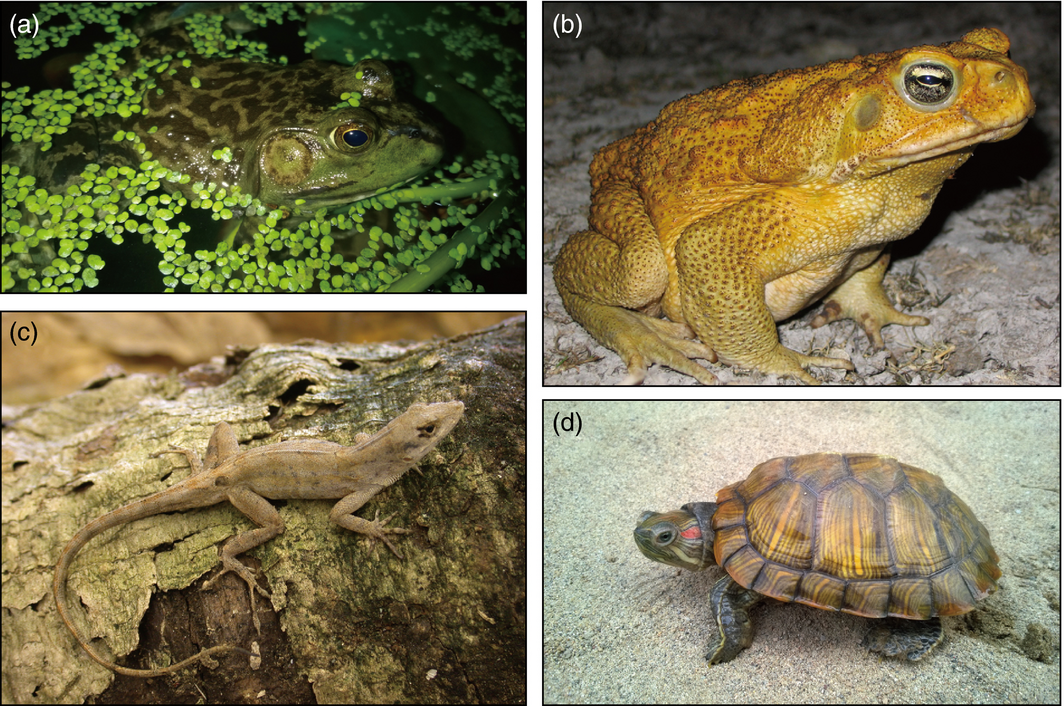Biodiversity hotspots are also hotspots of invasion
By Xianping Li, of the Key Laboratory of Animal Ecology and Conservation Biology within the Institute of Zoology at the Chinese Academy of Sciences in Beijing, China, as well as the University of Chinese Academy of Sciences in Beijing, China. Li and colleagues’ Research Communications paper “Risk of biological invasions is concentrated in biodiversity hotspots” appeared in the October 2016 issue of ESA Frontiers.

Four species of invasive reptiles and amphibians. (a) The American bullfrog (Lithobates catesbeianus) is responsible for spreading the chytrid fungus that has caused amphibian population declines and is a predator and competitor of many small vertebrates; (b) the cane toad (Rhinella marina) has poisoned native predators in Australia; (c) the brown anole (Anolis sagrei) out-competes and consumes native lizards; and (d) red-eared sliders (Trachemys scripta) hybridize with and compete with native turtles. Credit, B Phillips. From Figure 1 of Li et al 2016 Front Ecol Environ 14(8): 411–417.
Biological invasions are a major threat to global biodiversity and ecosystem functioning. Locating “invasion hotspots,” or areas with suitable conditions for numerous alien species, is crucial to prioritizing conservation efforts to prevent or mitigate impacts from invasive species.
My colleagues and I identified invasion hotspots around the world for 279 species of alien reptiles and amphibians under current and future climates (projected for the 2050s and 2080s) using an ensemble of five models. Under current conditions, the areas that are most prone to invasion are located in western Africa, South and Southeast Asia, the Caribbean, eastern South America, the Mediterranean region, and eastern Madagascar. Under future conditions, these invasion hotspots will expand toward the north of South America, into central Africa, and toward high-latitude areas of Europe.
Unfortunately, invasion hotspots for reptiles and amphibians appear to be more concentrated in and around “biodiversity hotspots,” or areas rich with species that do not live anywhere else. Indeed, the potential number of species of alien reptiles and amphibians per unit area is 1.4 times higher in biodiversity hotspots than in other regions.
Many biodiversity hotspots occur in areas with relatively limited financial resources. Developing and implementing effective biosecurity measures in these places may be complicated. Our study highlights the importance of early detection and rapid response programs to help counter biological invasions in biodiversity hotspots.
 Xianping Li, Xuan Liu, Fred Kraus, Reid Tingley, and Yiming Li. 2016. Risk of biological invasions is concentrated in biodiversity hotspots. Frontiers in Ecology and the Environment 14(8): 411–417. Doi:10.1002/fee.1321
Xianping Li, Xuan Liu, Fred Kraus, Reid Tingley, and Yiming Li. 2016. Risk of biological invasions is concentrated in biodiversity hotspots. Frontiers in Ecology and the Environment 14(8): 411–417. Doi:10.1002/fee.1321